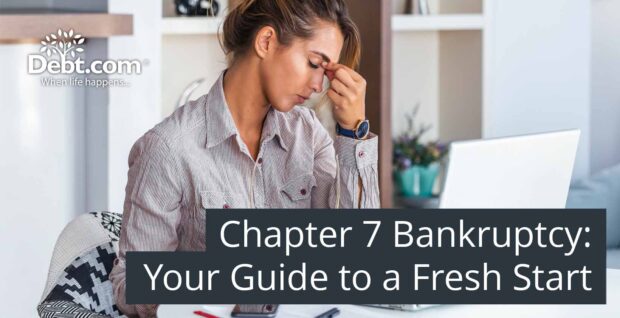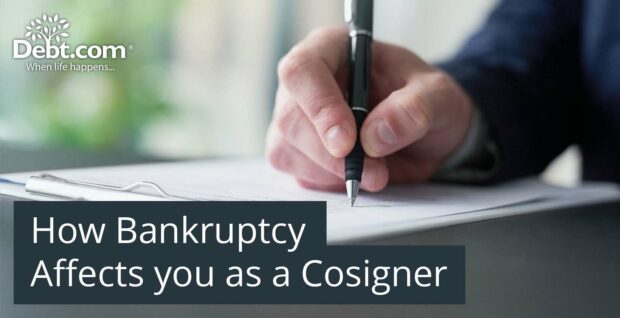
Declaring bankruptcy is a big choice that can frankly be extremely scary. But you might be surprised to learn that the pros often outweigh the cons of bankruptcy. Personal bankruptcy can give you a clean break from debt so that you can start over. It’s often the best way to turn the page quickly on debt problems.
Bankruptcy Explained: A Fresh Start or Last Resort?
Bankruptcy can feel like a financial lifeline—or a last resort, depending on your circumstances. At its core, it’s a legal process designed to help individuals or businesses overwhelmed by debt. Whether it’s eliminating your obligations or setting up a repayment plan under federal court protection, bankruptcy offers a way forward. It’s a decision that demands careful consideration, as it comes with significant benefits and challenges alike.
For individuals, the two most common types are:
- Chapter 7: Liquidates assets to pay creditors and discharges remaining eligible debts. This is often the quickest route to eliminating debt but can result in the loss of non-exempt property.
- Chapter 13: Establishes a repayment plan based on your income, letting you catch up on debts over time. This option is ideal for those with a steady income who want to keep their assets.
Bankruptcy isn’t without its challenges, but it can be a viable path for those facing insurmountable financial struggles. Understanding how it works and its implications is crucial for making an informed decision. This guide will help you weigh the pros and cons and determine whether bankruptcy is the right choice for your financial future.
The Pros of Filing Bankruptcy: Reasons It May Be the Right Choice
1. Debt Relief and a Fresh Start
Bankruptcy isn’t about avoiding responsibility; it’s about creating a framework to recover. This legal tool can be life-changing for those buried under debt. The ability to clear eligible debts like including credit cards, medical bills, and personal loans (Chapter 7) or restructure overwhelming debt (Chapter 13) offers a sense of freedom and control over your financial future. This gives you the opportunity to rebuild with confidence, regain stability, and focus on long-term goals.
Additionally, the psychological relief from unrelenting financial pressure can enable individuals to reestablish balance in other areas of their lives, from relationships to career planning. With time and guidance, this fresh start can pave the way for a healthier financial life.
2. Protection from Creditors
Filing for bankruptcy triggers an automatic stay, which halts collection activities such as harassing phone calls, lawsuits, and wage garnishments. Bankruptcy can also temporarily pause the foreclosure and repossession process.
This protection can be a lifeline for individuals who are constantly dealing with aggressive creditor tactics. It creates an environment where you can strategize effectively with legal and financial advisors and focus on recovery.
3. Asset Exemptions and Retention
Bankruptcy laws are designed to offer a fresh start, not to strip you of everything. Many states have exemptions that allow you to retain essential assets like your home, vehicle, and retirement savings.
For example, a family struggling with debt might be able to keep their primary residence and a vehicle necessary for work.This ensures they maintain stability while working towards a debt-free future.
In many cases, individuals find that the safety nets provided by these exemptions make bankruptcy a much less daunting prospect than they initially feared. With a clear understanding of your rights, you can navigate the process with greater confidence and a path towards financial recovery.
4. Emotional and Mental Relief
Living with overwhelming debt takes a toll on your mental health. Bankruptcy can alleviate this burden by offering closure and a clear path forward. Imagine no longer worrying about creditor calls or the fear of losing your home. That sense of relief alone can be transformative. It allows individuals to focus on rebuilding their lives with a renewed sense of hope and direction.
Mental health improvements are often overlooked, but they are a significant advantage of bankruptcy. Many individuals report feeling a sense of empowerment as they take proactive steps to regain control over their financial lives. This newfound confidence often sparks additional positive changes, such as improved relationships and a more proactive approach to financial education and planning for the future.
The Cons of Filing Bankruptcy: Challenges You Should Consider
1. Credit Score Impact and Long-Term Financial Consequences
Bankruptcy stays on your credit report for 7–10 years, depending on the type filed. This can make securing loans or even rental agreements challenging.
While the initial impact on your credit is significant, there are strategies that can help you rebuild your creditworthiness. You can steadily improve your credit score by getting secured credit cards or small loans. Keeping your balances low, paying bills on time, and maintaining a consistent payment history will also help improve your score. Remember, the temporary damage to your credit is often outweighed by the long-term benefits of eliminating unsustainable debt.
2. Loss of Non-Exempt Assets
When filing for Chapter 7 bankruptcy, non-exempt assets may be subject to liquidation to repay creditors. These assets can include luxury items, second homes, or other valuable possessions.
If you’re concerned about losing sentimental items or assets tied to long-term goals, a thorough consultation with a bankruptcy attorney is essential to guide you through the process and ensure you make informed decisions. Your attorney can:
- Assess your assets: Determine which assets are exempt and which may be subject to liquidation.
- Prepare you for potential asset sales: Help you understand the liquidation process and its potential impact.
- Minimize surprises: Proactively address potential issues and reduce unexpected consequences.
- Explore alternative solutions: Discuss options like debt negotiation or Chapter 13 bankruptcy that may help you preserve valuable assets.
This foresight ensures that you’re maximizing the benefits of bankruptcy while minimizing its drawbacks.
3. Social and Emotional Stigma
Bankruptcy carries a stigma, often misunderstood as failure rather than a strategic financial decision. Millions, including high-profile individuals, have used bankruptcy as a tool for recovery. It’s about finding a path towards recovery, not admitting defeat.
Still, the emotional and social impact shouldn’t be ignored. It’s important to remember that you are not alone. Building a support network, whether through friends, family, or support groups specifically for individuals experiencing financial hardship, can provide invaluable emotional support and guidance.
Bankruptcy is a legal and financial strategy—not a moral failing. Acknowledging the courage it takes to seek a solution to financial struggles can shift the narrative in a positive direction and help you recover.
4. Limitations on Debt Discharge
Bankruptcy doesn’t eliminate all debts. Obligations like student loans, child support, alimony, and certain taxes often remain. Understanding these limitations ensures you make informed decisions. For example, individuals whose primary debts are student loans might need to explore alternative repayment plans or consider other debt relief options.
Financial counselors or legal advisors can provide valuable guidance by helping you set realistic expectations, exploring all available options, and developing a comprehensive debt management plan tailored to your unique circumstances.
Exploring Alternatives to Bankruptcy
Before taking the leap, consider these debt management options:
- Debt Consolidation: Combines multiple debts into a single payment, often with a lower interest rate.
- Debt Settlement: Negotiates reduced balances with creditors, though it may impact your credit.
- Credit Counseling: Provides budgeting advice and repayment strategies.
Each alternative has its pros and cons. For example, debt consolidation simplifies payments but requires a strong credit score, while credit counseling offers guidance without directly eliminating debt.
These options can provide a middle ground for those who want to avoid the more drastic measures of bankruptcy, and combining solutions may provide even greater flexibility and control. Many find that starting with these alternatives allows them to exhaust less severe measures before turning to bankruptcy as a final option.
Deciding If Bankruptcy Is Right for You
Assess Your Financial Situation
Before considering bankruptcy, it’s crucial to carefully assess your current financial situation.
- Analyze your income and expenses: Track your income and expenses meticulously to understand your cash flow.
- Calculate your debt-to-income ratio (DTI): This ratio helps determine how much of your monthly income goes towards debt payments.
- Evaluate your debt load: Assess the total amount of debt you owe and determine if you can realistically repay it within a reasonable timeframe.
If your debts are consistently unmanageable despite your best efforts, you’ve exhausted other debt management options, and your debt-to-income ratio indicates significant financial strain, bankruptcy may be worth considering.
Consulting a financial advisor or bankruptcy attorney can provide clarity and help you determine the most appropriate course of action.
Timing and Legal Considerations
Timing is critical when considering bankruptcy. Key considerations include:
- Immediate Need: If you’re facing imminent wage garnishment, foreclosure, or repossession, filing for bankruptcy may offer immediate protection.
- Long-Term Stability: Consider your future financial goals. Bankruptcy can impact your credit for years, so it’s best to file when you’re prepared to rebuild your financial life.
- Legal Deadlines: Be aware of deadlines for filing lawsuits against you. Bankruptcy can stop these lawsuits, but you may lose the ability to defend yourself if the deadline passes.
- Timing of Large Purchases: Avoid making significant purchases (like cars or electronics) shortly before filing. These assets may be considered part of your bankruptcy estate and subject to liquidation.
- Transferring Assets: Be cautious about transferring assets to others before filing. This could be seen as fraudulent and may jeopardize your bankruptcy discharge.
There are also important legal considerations to keep in mind. These include:
- Eligibility: You may need to pass a means test to qualify for Chapter 7 bankruptcy. This test determines if your income is above a certain threshold. For Chapter 13, you must have sufficient income to make the monthly debt payments outlined in your bankruptcy plan.
- Debt Limits: There are limits on the amount of unsecured debt (credit cards, medical bills) and secured debt (mortgages, car loans) eligible for Chapter 13.
- Credit Counseling: You must complete a credit counseling course approved by the U.S. Trustee Program before filing for bankruptcy.
- Financial Disclosure: You must provide detailed financial information, including income, expenses, assets, and liabilities.
Legal advice ensures you’re making the right moves at the right time. Being strategic about when and how you file can greatly affect the outcome of your case. Proper planning can also help you take advantage of exemptions and prevent unnecessary complications, ensuring the process works in your favor.
Key Takeaways: Making an Informed Decision
Filing for bankruptcy is a serious step with lasting implications, but it isn’t a financial death sentence; it’s a tool for recovery when used wisely. It offers a fresh financial start and relief from creditors but also comes with challenges like credit damage and potential asset loss.
By exploring alternatives, seeking professional advice, and weighing the pros and cons carefully, you can choose the best course of action. Whether it’s bankruptcy or another strategy, taking action today can set the stage for a brighter, more secure tomorrow. Every step forward, no matter how small, moves you closer to financial freedom.












